This article is my personal report, in which I will share my fasting experience as well as interesting facts and hacks that I discovered while fasting. If you’re interested in the theory and a bit of science behind fasting in particular, check out the previous article.
I started my three-day fast on January 29, 2023, and ended it on February 1.
Preparation for the fast
Personally, I have a lot of experience with intermittent fasting (IF) and I have also tried prolonged fasting (PF) a couple of times in my life, the longest episode of which lasted a total of three days. Thanks to a lot of information available on the net and in books, I had no problem to prepare myself properly for fasting.
The most crucial thing I would emphasize for any fasting person is not to overeat before the 3-day fast. Personally, this hasn’t been a problem for me, as I eat according to IF practically every day. A few days before the fast, I pushed my preparation even further and jumped on the OMAD regime. OMAD is a great pre-fasting hack that I definitely recommend. However, if you notice yourself losing too much energy before the fast due to the one meal a day regime, feel free to indulge in 2 or 3 meals. I personally used to manage to eat OMAD for 10 days before fasting, other times it was a problem and I ate more often. Whether this works for you ultimately depends entirely on your individual preferences and metabolism.
Throughout the fasting period, I did trapeze and barbell exercises every day, as well as practicing the Wim Hof breathing exercise followed by a cold shower. A glucose meter and an Oura ring helped me collect data from my body.
Beginning
On January 29, I subsisted on bulletproof pu-erh, steak and avocado. I finished my last meal (a piece of steak with butter and an apple) at 4:50pm.
To be completely accurate, I actually finished my last meal at 5:35pm. It was a piece of butter with the nootropic Powerlogy Brain Focus.
From that point on, I didn’t put anything in my mouth besides water and salt for 72 hours.
I finished the evening of January 29 by taking a walk and drinking some sea salt water. No significant hunger was experienced.
Day 1
About an hour after waking up (11:00) my blood sugar was 4.1 mmol/l. In the morning I was bothered by a pretty strong feeling of cold.
5 minutes after Wim Hof and a hardening in the shower, my sugar dropped to 3.9.
At 12:30 I went outside to exercise for half an hour and practically immediately after returning home I measured my sugar, which was 4.8.
Throughout the day, I took about 4 grams of a mixture of Himalayan and sea salt dissolved in water.
Ketosis begins to kick in after about 12 to 16 hours of fasting, which I felt perfectly that day due to my own increased acidic body odor (but which could be counteracted by increased salt intake).
You already know from the last article that about 24 hours after the start of fasting, autophagy peaks as there is a significant suppression of the TOR kinase protein. This is a state that a person practicing intermittent fasting has no chance of getting into. And perhaps that is why the first day of fasting was the most challenging for me.
In the evening I felt extremely cold (even with the heating on), my calf muscles were getting cramped, and I was experiencing some strange feverishness. Only the infrared sauna stopped the shivering.
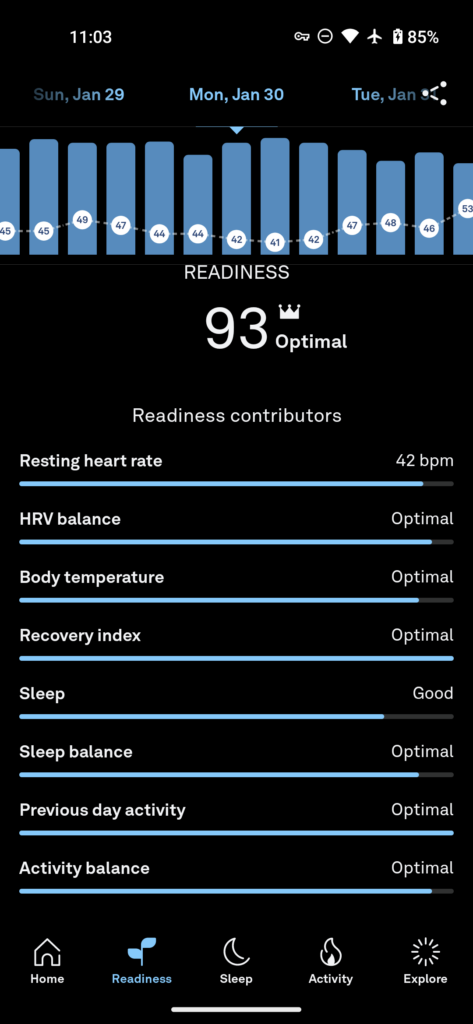
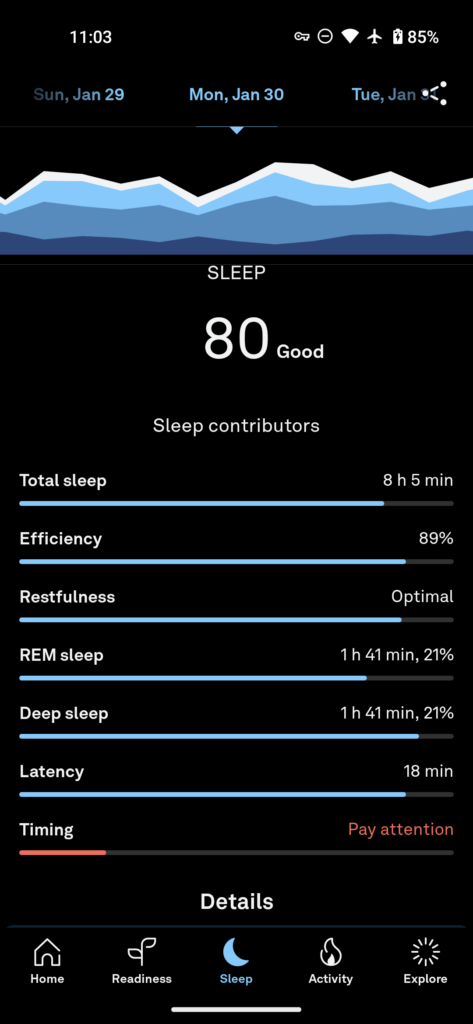
Day 2
The peak of my autophagy was over and the next morning was completely smooth sailing. The night was characterized by a significant REM phase of sleep (which the data from Oura will confirm), and apart from a significant thirst, I felt completely relaxed in the morning. I was not cold and I did not miss food.
Because of the experience with muscle cramps and cold, I increased my salt intake to something around 5 grams per day (and especially before the workout).
My sugar was 3.4 an hour after waking up, dropped to 3.3 after the hardening, and rose to 3.7 after the workout (this time after a pretty poor workout, as I lacked energy).
The day continued with grocery shopping, but its most interesting moment was a nearly three-hour walk between 5pm and 8pm, during which I decided to inhale CBD-containing cannabis vapor. During the walk I was extremely cold, shivering and practically every step I took was a problem. However, after a few puffs of CBD hemp, everything changed. I didn’t feel energized in any way, but rather felt “normal”. I stopped feeling hungry and I also stopped feeling cold. I picked up my stride and even ran for a few dozen meters to get my blood pumping more in my body.
I was able to spend the next three hours in the slightly sub-zero temperature and walk a little over 15 kilometers, thanks to the CBD hemp-hacked motion.
During the walk, I kept “torturing” myself by constantly discussing food and anything somewhat food related with my friend. When I got home, I compounded my torture by watching videos about food preparation, etc.
This torture undoubtedly had its desired effects. I had trouble falling asleep, I was constantly thinking nostalgically about food, I felt terribly hungry and my saliva was flowing. No wonder. According to studies, just thinking about food can get the insulin in the body to kick in. And that’s nothing pleasant during a fast.
My salivation was mainly due to the medulla oblongata, which controls various bodily functions from sneezing to vomiting.
When a person smells food or even thinks about it, a signal is sent to the primary salivary centers of the brain in the medulla oblongata. In doing so, the brain releases neurotransmitters such as acetylcholine and norepinephrine, which initiate nerve signals that command the salivary glands to produce saliva.
My insomnia, in turn, was caused by the “hunger hormone” ghrelin, which, in addition to increasing appetite, also controls the sleep cycle. However, we’ll talk more about ghrelin below.
Most importantly, I was able to get out of this sleepless, slobbery state by listening to a podcast, which managed to make me think about other things than food. My sleep was pretty good, but I was still dreaming about food all night long (see dates from February 1).
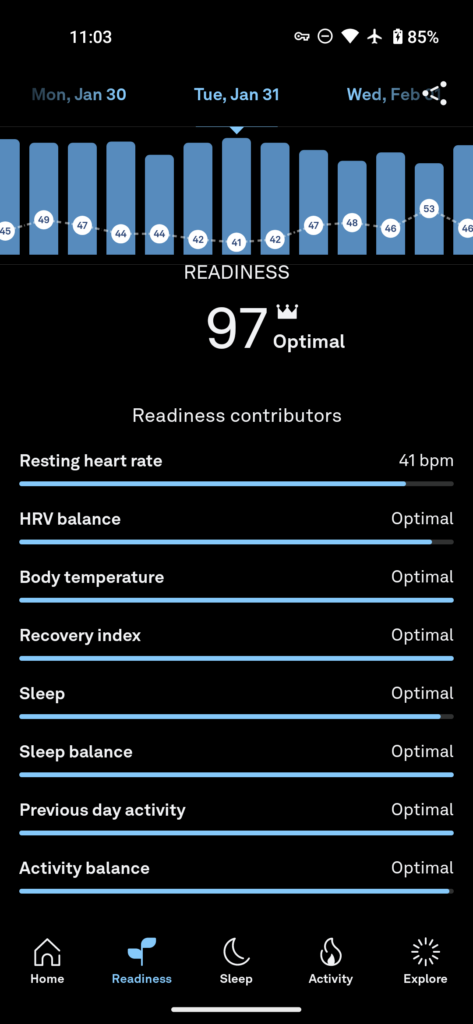
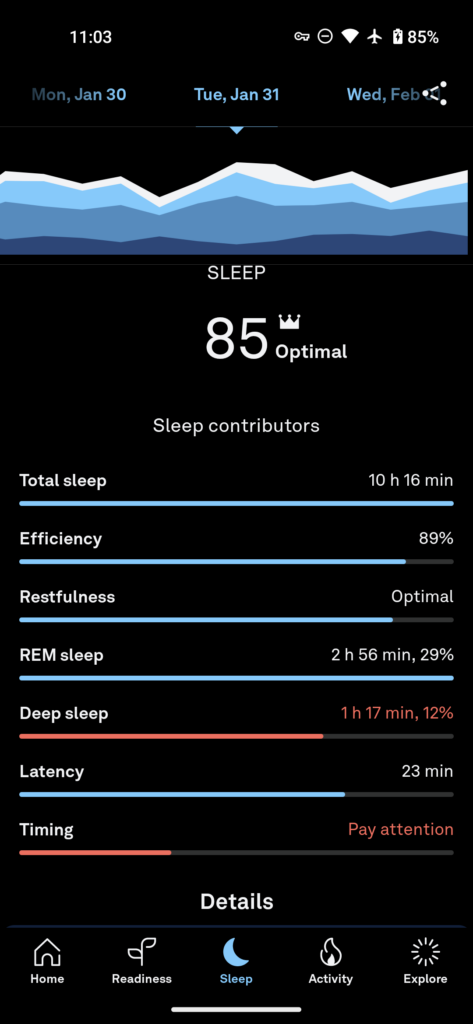
Day 3
This time I started the morning by adding some lemon juice to my usual glass of water with salt, thinking that the morning acidity would help raise my cortisol. Whether it did or not, I didn’t feel anything particularly different compared to the previous days of the fast. My blood sugar was even exactly the same as the previous day (3.4) and even after a cold shower (3.3).
A light workout followed, after which my sugar climbed to 3.5. I devoted the afternoon to a walk and at 5pm I had my first caffeinated drink (Hojicha Shizuoka) of the fast and then measured my sugar before my first meal in 72 hours. The sugar was 3.4.
At 5:20pm I ate my first meal (2 eggs, a quarter of an avocado and a handful of cashews) and at 6pm I measured my blood sugar, which this time came in at 3.2. And that’s lower than I’ve measured at any time during a fast (!?).
Thinking that it was a bad measurement, or that my body had “burned” the eggs very quickly and my insulin had managed to drop by then, I ate one more egg and half an avocado. At 18:15 I measured my blood sugar again and this time it was 3.6.
This phenomenon of dropping sugar is called “reactive hypoglycemia” and can occasionally occur after eating a ketogenic meal. Nevertheless, the causes are not yet well known.
However, the meal was very satisfying and I immediately felt the energy I needed afterwards. The next day I was eating completely normally 🙂
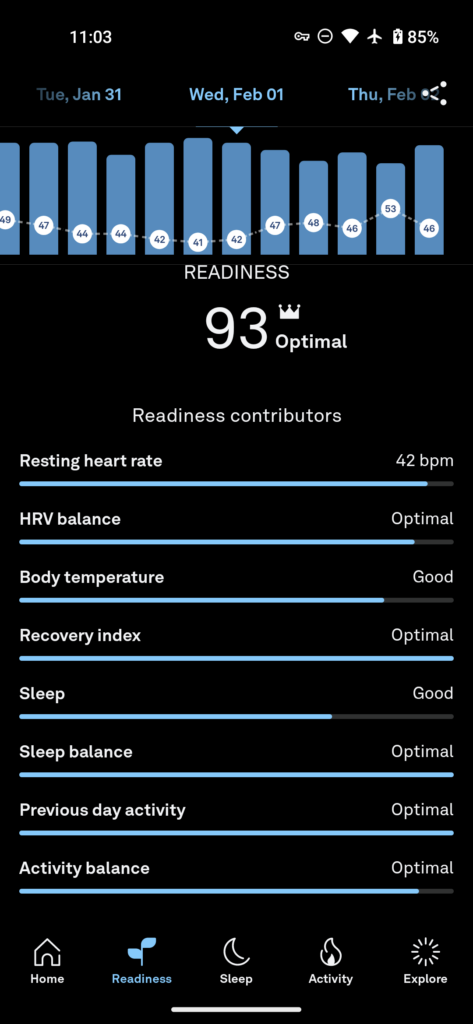
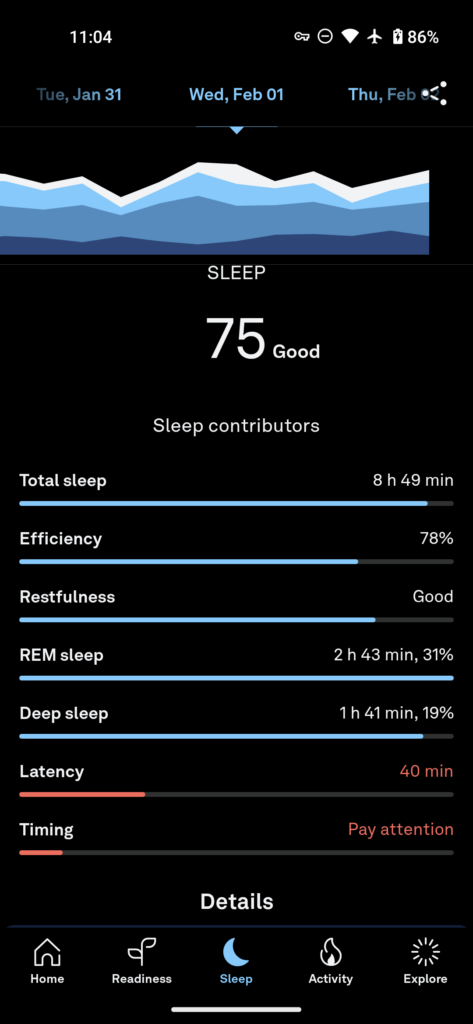
Recommendations, observations and minor hacks to conclude
In this section, I would like to share small lifehacks and observations that have served as humble lessons from my three-day fast.
Cold shower and fasting
Although Wim Hof and even a cold shower is an intense stressor that boosts cortisol (and boosted cortisol boosts blood sugar), my own measurements have claimed something different. For three days in a row, my blood sugar was down significantly after the Wim Hof.
How is this possible? This study confirms, for example, that a cold shower can lower your blood sugar considerably if the cold induces a shivering response in your body.
And this is very crucial. Because when I wasn’t fasting any extra, I was used to the cold shower getting my blood flowing, getting my cortisol pumped up and giving me instant energy. In the case of fasting, however, it was different. After the cold shower, I started shivering (and my sugar went down) and I was shivering practically until I started exercising (and my sugar went back up). So hardening off is no collective sport, but a purely individual affair. And during a fast, this is doubly true. Watch out for the shivers and sugar crashes.
Cannabis and thermoregulation
According to studies, CB1 receptors, which are predominantly located in the central nervous system and the brain, are responsible for thermoregulation. As CBD also binds to these types of receptors, this could explain its ability to improve thermoregulation, but not as significantly as THC; which interacts with CB1 receptors at a much higher level than CBD. In fact, the primary domain of CBD is CB2 receptors located in the peripheral nervous system. If you want to learn a little more about biohacking with cannabis, be sure to read the blog on cannabinoids.
Studies on cannabis and thermoregulation are still in their infancy, but so far it seems that vaping/smoking cannabis improves thermoregulation precisely by increasing the temperature of the so-called voluntary muscles – the muscles that are responsible for the shivers during the cold. This would explain the miraculous energy I felt after vaporizing cannabis.
Weed can be a great fasting hack, among other things, if you happen to want to intentionally induce the munchies and test your willpower 😉
Hacking the ghrelin
Ghrelin is exactly the miracle that is responsible for the munchies. It’s a hormone produced in the intestines. It is often referred to as the “hunger hormone” and is sometimes referred to as lenomorelin.
It travels through the bloodstream to the brain where it tells the brain to be hungry and seek out food. And yes, ghrelin synthesis is also promoted by cannabis.
Although the main function of ghrelin is to increase appetite, it is also responsible for controlling circadian rhythms (this is why I couldn’t fall asleep after watching food videos), reward-seeking behavior, taste sensations, and carbohydrate metabolism. Ghrelin drives our behavior and our motivation, and anyone who doesn’t have their ghrelin levels in order will suffer quite a bit while fasting.
And although ghrelin seems to be a hormone that (outside of cannabis) can’t be controlled much with diets, medications, or supplements, there are a few natural ways in which you can spike healthy ghrelin levels so you don’t have to suffer from fake hunger, and not just during fasting:
- Maintain a healthy weight and don’t diet. Studies clearly show that classic diets based on the “eat less and don’t care what to eat or when to eat” protocol are associated with increased ghrelin levels. The body is therefore more hungry and will therefore also overwhelm your mind with thoughts of food more often.
- Watch your sleep. Lack of sleep is associated with higher food cravings and therefore weight gain. And, of course, ghrelin is to blame, according to studies.
- Gain muscle mass. Why? Because more muscle and less fat equals less ghrelin.
- If you’re a post-menopausal woman, watch out for fluctuating weight. According to one older study on post-menopausal women, drastic weight changes and yo-yo dieting can significantly disrupt the activity of many key hormones, including ghrelin.
Besides that, leptin; the satiety hormone, also plays a key role in the feeling of hunger. Studies will tell us that people who fast (whether PF or IF) are the ones who have an increased sensitivity to leptin. Many people who have their leptin properly hacked due to fasting, or just eating a low carb/ketogenic diet, don’t get thrown out of ghrelin balance by some cannabis plant and don’t feel hungry after consuming it.
(Some) salt is a friend
There are a lot of myths about salt, which I have managed to debunk quite successfully in this article.
However, salt can provide a lot of energy (and especially heat, as salt improves blood circulation) during fasting, but movement must not be neglected. Salt deficiency can cause nausea, muscle cramps and stomach pain during fasting.
Many sources recommend consuming 3 to 4 grams of salt while fasting, but I personally have increased my intake to 5 to 6. When a person is moving and exercising, more salt certainly doesn’t hurt. But beware; too much salt causes laxation!
Each of us should therefore find our own optimal dose.
And of course, sodium is not everything. That’s why I don’t use table salt and only use sea salt or Himalayan salt.
Himalayan salt in particular differs from table salt in that it consists of potassium chloride (table salt consists of sodium chloride). And it is this small difference that makes Himalayan salt a better choice for those who are fasting. Whether PF or IF.
The key electrolytes that need to be replenished during fasting are sodium, chloride, potassium and magnesium. Conventional salt will more or less supply you with the first two of these, Himalayan salt can certainly supply the first three of these. With magnesium it gets a little more complicated.
Since pink Himalayan salt is truly natural and unprocessed, the amount of trace minerals in it can vary widely. Literally every sample of salt is different, and unfortunately, without a lab test, it’s impossible to determine exactly how much potassium or magnesium you’re getting in.
On pink Himalayan salt labels, trace minerals are usually listed either in some range or as a guideline amount.
A study conducted by Nutritional Research Australia tested 31 samples of retail Himalayan salt products for mineral composition. They found that the amounts ranged from 147 mg to 4454 mg per kg for magnesium and from 98 mg to 4528 mg per kg for potassium. And these are huge differences. Nothing is 100%, so unless you do your own salt test, you can’t know for sure what ratio of minerals you’re consuming. What is certain, however, is that with Himalayan salt, your body will lose much less during a fast than with regular salt.
Conclusion
I would like to dedicate this part especially to those who have not yet tried fasting and are not yet fully decided whether they will actually try it.
It is a kind of my personal fasting feedback, which resonated in me especially during my very first fast in my life, but its content is still valid for me and I would therefore like to take it further.
1. More discipline than I expected
During my very first fast, I wasn’t too sure if I would be able to go 72 hours without food. However, I was pleasantly surprised by my own discipline and restraint towards food, even though there were temptations lurking all around me.
2. Fasting is good to “be influenced” or to keep it with someone!
It is not easy to fast solo while living in the same household with someone who is not fasting. Having a fasting-roommate definitely gives one more motivation to endure.
My personal hack for enduring the fast tends to be that I “influence” the fast and announce it publicly to my friends. I see such an announcement as a principle that can’t be broken.
3. Not as bad as I imagined
Before starting my first three-day fast, I expected it to be absolute hell. Although I didn’t exactly like everything about it, it was very interesting for me to observe my body’s reaction to the absence of food. I thought I would be irritable and nervous, but I wasn’t. Hunger seemed to come and go over the course of the 3 days, but I’d be lying if I didn’t say that about halfway through the trip I thought about having a decent steak.
4. I will fast again
Fasting provides many amazing health benefits. I’ve always been a fan of intermittent fasting, but once I tried fasting for 3 days for the first time, it was a no-brainer that I would do it again someday. This fast almost felt like a detox to me. For some reason, it also made my day seem like it had more hours in it. I think from now on, I’m going to do one three-day fast every three months and one 24-hour fast once a month. So, since I’m a fan of longevity, I have a lot of fasting ahead of me.
